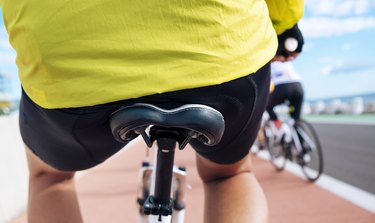
A long bike ride can, quite literally, be a pain in the rear. And bicycling-related tailbone pain can be more than just irritating; it derail your training and even dissuade you from future cycling.
Excess pressure on the tailbone, which is usually due to a lack of support or poor distribution of weight, can leave you with a sore coccyx after a ride. A variety of riding errors and environmental conditions can also cause it. But by making a few small adjustments to your bike, you can go for longer rides more comfortably.
Video of the Day
Video of the Day
Thankfully, if you understand how tailbone pain can happen during or after bike riding, you can ease it — and even prevent it going forward.
Warning
About nine in 10 people who require treatment from tailbone injury fully recover with at-home remedies, according to the Cleveland Clinic.
So if you experience chronic or severe tailbone pain, talk to your doctor.
3 Causes of Sore Coccyx After Cycling
The repetitive actions of bike riding, especially if it's for long distances, can trigger tailbone pain (aka coccydynia), according to National Health Services UK.
While you can also develop pain if you fall off your bike or are an object behind you bumps you, most cases of tailbone pain from biking come down to poor cycling posture. And the biggest contributor of wonky posture? Incorrect bike setups.
If you have frequent tailbone issues after riding, stop in to you local bike shot for a professional bike fitting. Here are three things they'll definitely evaluate:
1. Handlebar Height
Having your bike handlebars too high doesn't allow your tailbone and spine to properly cope with irregularities and bumps in the road. Instead, it can jam your vertebrae together and place excess pressure on your tailbone.
2. Seat Tilt
The tilt of your bike seat can also be a cause of a sore coccyx after cycling. If your seat shifts your pelvis too far forward or backward, it could alter your balance, according to the Adventure Cycling Association. If your pelvis moves back onto your tailbone, it can potentially lead to coccyx injury from cycling.
Your seat should be parallel to the ground, So check to make sure it's not tilted.
3. Seat Height
Check the seat height while you're at it — a seat that's too low could cause tailbone pain as well. A low seat allows you to rest more of your body weight onto your tailbone.
5 Ways to Help Prevent Tailbone Pain After Biking
If you're already experiencing tailbone pain after a bike ride, the Cleveland Clinic recommends taking a break from bike riding until symptoms cease.
And put these three preventative methods in place to help get rid of tailbone pain during future rides.
1. Explore Seat Types
Very hard seats increase pressure on the tailbone, per the Cleveland Clinic. So it might seem like a highly cushioned seat is the best bicycle seat for pain with cycling. But over-padding your saddle could do more harm than good by upsetting your balance and displacing pressure.
Instead, look for a bike seat that supports your sit bones evenly. A seat that features gel contours or is wider may also be more comfortable for a sensitive tailbone.
The Best Bike Seats for Tailbone Pain
- Bikeroo Memory Foam Bike Saddle, Wide (Bikeroo.com, $37.99)
- Serfas Tailbones Comfort Saddle (Amazon.com, $34.95)
- Velmia Bike Seat Made of Comfortable Memory Foam (Amazon.com, $29.99)
- Cloud 9 Cruiser Select Saddle (Amazon.com, $31.82)
- Cloud 9 MX Airflow Bike Seat (BikeSeats.com, $15.99)
2. Consider Padded Bike Shorts
Your cycling gear can help you protect your tailbone and decrease the risk of a bruised coccyx from cycling.
By investing in a pair of cycle shorts that offer a padded chamois, you can do away with inner leg chafing and help pad your tailbone for a more comfortable ride. You may need to try a variety of bike shorts to find the pair that works best for you.
Related Reading
3. Bridge Your Back
Ride with your back slightly arched like a bridge rather than dropped between your neck and hips. This will allow your back to flex a bit when you go over a bump or road irregularity instead of bowing farther in the forward direction.
Also, try to limit time spent leaned back in your seat. According to a spring 2014 article in the Ochsner Journal, the coccyx is the third leg of a tripod of bones that support your body weight in a seated position. Pain in this area — officially called coccydynia — typically increases when a person leans back in a seated position.
4. Take Standing Breaks
While riding, try standing up on your pedals when your tailbone feels sore or you have a numb rear. The short break can help increase blood flow to your bottom, which can help reduce pain.
5. Shorten Your Rides
Finally, if you're new to cycling, altering your training and rides to account for your sore tailbone can help decrease pain and could also help you build up strength in the muscles around your tailbone over time.
Shorter rides may be more appropriate when you're getting started. By training and increasing ride lengths slowly, you may experience less pain.
Related Reading